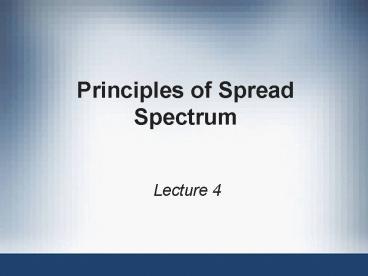Principles of Spread Spectrum - PowerPoint PPT Presentation
1 / 36
Title:
Principles of Spread Spectrum
Description:
Principles of Spread Spectrum Lecture 4 * * * * * * * * * * Summary Three modulation schemes are used in IEEE 802.11 wireless LANs: frequency hopping spread spectrum ... – PowerPoint PPT presentation
Number of Views:184
Avg rating:3.0/5.0
Title: Principles of Spread Spectrum
1
Principles of Spread Spectrum
- Lecture 4
2
Objectives
- List and describe the wireless modulation schemes
used in IEEE WLANs - Tell the difference between frequency hopping
spread spectrum and direct sequence spread
spectrum - Explain how orthogonal frequency division
multiplexing is used to increase network
throughput
3
Introduction
Figure 4-2 OSI data flow
4
Introduction (continued)
Table 4-1 OSI layers and functions
5
OSI model
6
WLan technologies
7
Infrared
8
Narrowband Transmission
- Narrowband transmission used primarily by radio
stations - Radio signals by nature transmit on only one
radio frequency or a narrow portion of
frequencies - Require more power for the signal to be
transmitted - Signal must exceed noise level
- Total amount of outside interference
- Vulnerable to interference from another radio
signal at or near same frequency - IEEE 802.11 standards do not use narrowband
transmissions
9
Narrowband Transmission (continued)
Figure 4-3 Narrowband transmission
10
Spread spectrum
11
Spread Spectrum Transmission
Figure 4-4 Spread spectrum transmission
12
Spread Spectrum
13
Spread Spectrum Transmission (continued)
- Advantages over narrowband
- Resistance to narrowband interference
- Resistance to spread spectrum interference
- Lower power requirements
- Less interference on other systems
- More information transmitted
- Increased security
- Resistance to multipath distortion
14
Two approaches for SS
15
Frequency Hopping Spread Spectrum (FHSS)
- Uses range of frequencies
- Change during transmission
- Hopping code Sequence of changing frequencies
- If interference encountered on particular
frequency then that part of signal will be
retransmitted on next frequency of hopping code - FCC has established restrictions on FHSS to
reduce interference - Due to speed limitations FHSS not widely
implemented in todays WLAN systems - Bluetooth does use FHSS
16
Frequency Hopping Spread Spectrum (continued)
Figure 4-6 FHSS error correction
17
Frequency hopping
18
Direct Sequence
19
Direct Sequence Spread Spectrum (DSSS)
- Uses expanded redundant code to transmit data
bits - Chipping code Bit pattern substituted for
original transmission bits - Advantages of using DSSS with a chipping code
- Error correction
- Less interference on other systems
- Shared frequency bandwidth
- Co-location Each device assigned unique chipping
code - Security
20
Direct Sequence Spread Spectrum (continued)
Figure 4-7 Direct sequence spread spectrum
(DSSS) transmission
21
DSS frequency change plan
22
Radio Modulation
23
Orthogonal Frequency Division Multiplexing (OFDM)
- With multipath distortion, receiving device must
wait until all reflections received before
transmitting - Puts ceiling limit on overall speed of WLAN
- OFDM Send multiple signals at same time
- Split high-speed digital signal into several
slower signals running in parallel - OFDM increases throughput by sending data more
slowly - Avoids problems caused by multipath distortion
- Used in 802.11a networks
24
Orthogonal Frequency Division Multiplexing
(continued)
Figure 4-8 Multiple channels
25
Orthogonal Frequency Division Multiplexing
(continued)
Figure 4-9 Orthogonal frequency division
multiplexing (OFDM) vs. single-channel
transmissions
26
Comparison of Wireless Modulation Schemes
- FHSS transmissions less prone to interference
from outside signals than DSSS - WLAN systems that use FHSS have potential for
higher number of co-location units than DSSS - DSSS has potential for greater transmission
speeds over FHSS - Throughput much greater for DSSS than FHSS
- Amount of data a channel can send and receive
27
Comparison of Wireless Modulation Schemes
(continued)
- DSSS preferred over FHSS for 802.11b WLANs
- OFDM is currently most popular modulation scheme
- High throughput
- Supports speeds over 100 Mbps for 802.11a WLANs
- Supports speeds over 54 Mbps for 802.11g WLANs
28
Key modulation techniques
29
Modulation techniques used by 802.11a
- Modulation techniques used to encode 802.11a data
vary depending upon speed - Speeds higher than 54 Mbps may be achieved using
2X modes
Table 4-7 802.11a characteristics
30
Physical Layer Standards (continued)
Figure 4-19 Phase shift keying (PSK)
31
Physical Layer Standards (continued)
Figure 4-20 Quadrature phase shift keying (QPSK)
32
Physical Layer Standards (continued)
Figure 4-21 16-level quadrature amplitude
modulation (16-QAM)
33
Physical Layer Standards (continued)
Figure 4-22 64-level quadrature amplitude
modulation (64-QAM)
34
Summary
- Three modulation schemes are used in IEEE 802.11
wireless LANs frequency hopping spread spectrum
(FHSS), direct sequence spread spectrum (DSSS),
and orthogonal frequency division multiplexing
(OFDM) - Spread spectrum is a technique that takes a
narrow, weaker signal and spreads it over a
broader portion of the radio frequency band - Spread spectrum transmission uses two different
methods to spread the signal over a wider area
FHSS and DSSS
35
Summary (continued)
- OFDM splits a single high-speed digital signal
into several slower signals running in parallel
36
Lab
- 3-3
- 4-1 and 4-3 from text book































